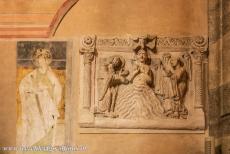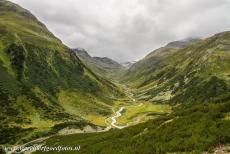The Benedictine Convent of St. John at Müstair was founded around 775, probably on the orders of Charlemagne, to give thanks for his safe passage of the Alps. The convent is one of the few existing architectural examples from the Carolingian period. The Benedictine Convent of St. John at Müstair is well known for its Carolingian frescoes from around 800 AD and its 12th century Romanesque frescoes and stuccoes, they are the most important series of figurative murals in Switzerland. The series of frescoes adorns the entire Carolingian St. John's Church. There is also a statue of Charlemagne in the St. John's Church. The original Carolingian St. John's Church and the Chapel of the Holy Cross survived largely intact. The fortified Planta Tower was erected around 960 to provide protection against the barbarians threatening the Holy Roman Empire of Otto I. The Planta Tower is considered the oldest fortified residential tower in the Alps. In 2015, around twelve nuns still lived in the Convent of St. John at Müstair. Müstair is the easternmost village in Switzerland. The tiny village has been known since 1923 by his Rhaeto Romance name Müstair rather than the German Münster. The Convent of St. John is situated in the Val Müstair. The Val Müstair is, together with the adjoining Swiss National Park Naziunal, the first UNESCO biosphere reserve in the high Alpine region.The Benedictine Convent of St. John at Müstair was declared a UNESCO World Heritage in 1983.
www.werelderfgoedfotos.nl © Copyright World Heritage Photos

The Benedictine Convent of St. John at Müstair is one of the few still existing buildings from the Carolingian period. The Convent of St. John at Müstair was founded around 775 AD, probably on the orders of Charlemagne, to give thanks for his safe passage of the Alps. The convent is famed for its Carolingian frescoes from around 800 AD and its 12th century Romanesque frescoes. The Benedictine Convent of St. John at Müstair was declared a UNESCO World Heritage in 1983.

The Benedictine Convent of St. John at Müstair is one of the few still existing buildings from the Carolingian period. The Convent of St. John at Müstair was founded around 775 AD, probably on the orders of Charlemagne, to give thanks for his safe passage of the Alps. The convent is famed for its Carolingian frescoes from around 800 AD and its 12th century Romanesque frescoes. The Benedictine Convent of St. John at Müstair was declared a UNESCO World Heritage in 1983.

Benedictine Convent of St. John at Müstair: The Chapel of the Holy Cross is situated at the cemetery of the convent. The chapel was also built in the Carolingian period. The Convent of St. John and the Chapel of the Holy Cross at Müstair are two of the few remaining buildings from the Carolingian period. The Chapel of the Holy Cross has a cloverleaf ground plan. Inside there are two small chapels, the two chapels are placed one on top of another.

Benedictine Convent of St. Johnt at Müstair: The High Altar of the convent church. The frescoes behind the high altar shows the beheading of John the Baptist. Originally the convent church of St. John was reserved exclusively for the convent, but during the Protestant Reformation in the 16th century it also became a parish church. The church of the Convent of St. John at Müstair is dedicated to John the Baptist.

Benedictine Convent of St. John at Müstair: The coat of arms of Charlemagne was painted in the vaulting. The statue of Charlemagne stands between the central apse and southern apse of the church. In the late 15th century and early 16th century, Gothic details were added to the church. Most notable is the Gothic vaulting. Also larger windows were cut into the south wall, thereby several paintings were destroyed.

Benedictine Convent of St. John at Müstair: A fresco of the Christ Pantocrator in the central apse of the Church of St. John the Baptist. The central apse is decorated with Carolingian frescoes of Christ surrounded by the twelve apostles and angels. The Christ Pantocrator refers to a specific depiction of Christ. The Benedictine Convent of St. John at Müstair was inscribed on the UNESCO World Heritage List in 1983.

Benedictine Convent of St. John at Müstair: The frescoes on the interior walls of the church date mostly from the early 9th century. Most of the scenes are from the live of Christ. The west wall of the church shows the Last Judgment. In later centuries the frescoes were covered in layers of white wash. The frescoes were rediscovered in the 20th century. The original Carolingian St. John's Church survived largely intact.

Benedictine Convent of St. John at Müstair: A high relief sculpture of the Baptism of Christ by John the Baptist. The high relief was mounted on the north wall of the church of St. John during the Gothic restoration. The baptism of Christ was the most important moment in the life of John the Baptist, more important than his decapitation. The church of the Convent of St. John at Müstair is devoted to John the Baptist.

Benedictine Convent of St. John at Müstair: A sundial on the wall of the Planta Tower. The fortified Planta Tower was erected around 960 AD, the interior was arranged as living quarters. The Planta Tower is considered the oldest fortified residential tower in the Alps. The tower is named after the Abbess Angelina von Planta who rebuilt the interior after a fire in 1499. Since 2003, the Planta Tower houses the convent museum.

The Planta Tower rises high above the Benedictine Convent of St. John at Müstair. The convent is situated in the Val Müstair, the most isolated valley of Switzerland. The Val Müstair, together with the adjoining Swiss National Park Naziunal, is the first UNESCO biosphere reserve in the high Alpine region. The Val Müstair is only accessible via the Ofen Pass from the remainder of Switserland.

The Ofen Pass, also known as the Fuorn Pass, is a high Alpine mountain pass in Switzerland. The Benedictine Convent of St. John at Müstair is situated in the Val Müstair, the most isolated valley of Switzerland. The Val Müstair is only accessible via the 2149 metres high Ofen Pass from the remainder of Switserland. The Ofen Pass is crossing the Swiss National Park Naziunal, the first UNESCO biosphere reserve in the high Alpine region.
